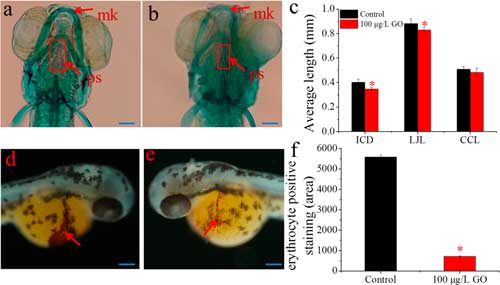| Posted: Jun 29, 2017 | |
Researchers verify the developmental toxicity of graphene oxide at trace concentrations(Nanowerk News) The environmental and health risks of graphene oxide (GO) attract considerable attention because of its wide-ranging applications in various field. |
|
| GO, an extensively studied carbon nanomaterial with single- or few-layer nanosheet morphology (read more: What is graphene?), shows tremendous potential applications in various fields, including the chemical industry, healthcare, electronic devices and environmental protection. | |
| Worldwide production and application of GO and GO-based materials will gradually but inevitably promote the release of GO into the environment. | |
| Investigations on the effect of GO on aquatic organisms are critical while GO is being released into the environment. | |
| Some studies have found that GO exhibited high toxicity to marine and freshwater algae, damaged organelles, enhanced ROS generation, induced nutrition depletion, and reduced photosynthetic pigment concentrations. | |
| GO was also found to penetrate the chorion and reach the zebrafish embryo, thus affecting zebrafish embryo development and causing DNA damage. | |
| In general, the estimated environmentally relevant concentrations (ERCs) of engineered nanomaterials in environmental media are at parts per billion (µg/L) or parts per trillion (ng/L) levels. | |
 |
|
| Effects of graphene oxide (GO) on skeletal and cardiac development of zebrafish larvae. a-b, Zebrafish larvae stained with alcian blue/alizarin red S at 7 dpf (a, control; b, 100 µg/L GO), the zebrafish display an evident decrease in head skeleton formation compared to control; c, average lengths of LJL, ICD and CCL of zebrafish determined using ImageJ; d-e, erythrocyte detection in the cardiac section of zebrafish at 48 hpf (d, control; e, 100 µg/L GO); f, relative number of erythrocytes, the brown coloration decreases in zebrafish exposed to 100 µg/L GO, the scale bar is 20 µm. *denotes a p-value < 0.05 compared to the control. Statistical significance is determined using Student’s t test. mk, Meckel’s cartilage; ps, parasphenoid; ICD, intercranial distance; LJL, lower jaw length; CCL, ceratohyal cartilage length. (© ACS) (click on image to enlarge) | |
| A new study by Chinese scientists, published in Environmental Science & Technology ("Molecular Mechanisms of Developmental Toxicity Induced by Graphene Oxide at Predicted Environmental Concentrations"), found that GO at predicted environmental concentrations induced developmental toxicity in zebrafish, including malformation, mortality, oxidative stress, skeletal developmental delay, and cardiac toxicity. | |
| The specific mechanisms were elucidated by transcriptomics and metabolomics assays. Consequently, government administrators and nanomaterial producers should consider the potential risks of trace GO to aquatic organisms and human health. |
 By
Michael
Berger
– Michael is author of three books by the Royal Society of Chemistry:
Nano-Society: Pushing the Boundaries of Technology,
Nanotechnology: The Future is Tiny, and
Nanoengineering: The Skills and Tools Making Technology Invisible
Copyright ©
Nanowerk LLC
By
Michael
Berger
– Michael is author of three books by the Royal Society of Chemistry:
Nano-Society: Pushing the Boundaries of Technology,
Nanotechnology: The Future is Tiny, and
Nanoengineering: The Skills and Tools Making Technology Invisible
Copyright ©
Nanowerk LLC
|
|
|
Subscribe to a free copy of one of our daily Nanowerk Newsletter Email Digests with a compilation of all of the day's news. |
